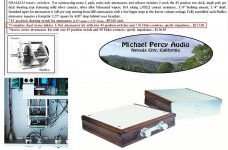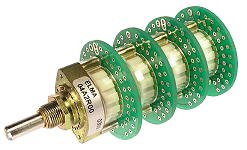Is there anything wrong with Elma Type 04 switches? The one in my preamp is in use for more than 4 years and it doesn't show any sign of oxidation. 🙂
jcarr said:And AFAIR, $237 isn't enough to buy the better Shallco switches (and not including any resistors). At least, not the ones that we use (which are admittedly custom specials).
Jonathan:
Allow me to make a small correction - I wrote $273 and not $237. This is the price of complete Shallco attenuators as stated at the Percy Audio webpage. If I'm not mistaken, this is the same exact type you use in your flagship Lyra (picture below). If I am mistaken, would you please explain what is "custom special" in your Lyra (which is a neat job, by the way).
My point is that John admittedly has a problem with the stuff he uses, which may be due to either TKDs or something far more serious...
Regards,
Milan
Attachments
I don't have a problem with TKD pots. I had heard about ONE complaint in the past. However, Bob Crump used to handle small problems like this, so there may have been more incidents, but it is next to insubstantial evidence to even think that I would build another attenuator that would have even more potential problems than the TKD.
"My point is that John admittedly has a problem with the stuff he uses, which may be due to either TKDs or something far more serious..."
Milan
Having worked on the retail and manufacturing side of the industry for the past four years I would hardly admit the oxidation of a contact as a problem. The fact that metal oxidizes over time does not mean that there is something wrong with his choice of parts or design in general.
Regards,
Nate
Milan
Having worked on the retail and manufacturing side of the industry for the past four years I would hardly admit the oxidation of a contact as a problem. The fact that metal oxidizes over time does not mean that there is something wrong with his choice of parts or design in general.
Regards,
Nate
But Nate, you should know that that gold does not oxidize and that silver oxide is as good a conductor as silver itself.
Regards,
Milan
Regards,
Milan
How about it Jonathan?
Long John Curl !
Quite revealing that Mr Carr still needs to blueprint such expensive switches. Enclosing the switch and filling it with oil is a silly option ?
Btw, you are welcome to hand over some goodies of the JC-1s, Mr Curl.
john curl said:Well I got you folks 'thinking'. 😉
MikeB, Stabilant 22 was made for the Canadian Telephone Co and sold in this country as Tweek. It is a microcrystaline grease.
I personally don't find listening through 'grease' as good as a clean, dry contact.
Ah how the memory fades concerning the tweek (it was just a memory lane type comment and my memory failed me). That's OK, my comments were based on the Caig products and I don't think I'm listening through anything with them. In fact an unprotected contact starts deteriorating immediately after being cleaned. As evidence, the contact thats starts working after being swiped back and forth will start to act up within a week or two at best. Those films just keep coming back.
Mike.
This is interesting. The Blowtorch apparently has attenuator-related issues that deserve a thread of their own. Somehow I'm starting to think there are no cleaning strategies for this.
Regards,
Milan
Regards,
Milan
Re: Mike B...
Hey, I have no problem with John's instructions 🙂. My comments were pointing out that someone was not trying something based on a discussion that really didn't have any meat to it. It's like buying stereo gear after reading a review.
My point was, I have experience with it, I've done my home work over the years, there's documentation availible if anyone's interested, here's my opinion.
I'm in the Richmond area, it's beautiful this time of year.
Mike.
Geophysicist said:As I said, I think it's good stuff for a number of applications. I use it (lightly) on my RCAs and speaker cable spades every 6 months or so. But when the designer of my preamp tells me that he wouldn't use it on his contacts and that there's something out there as easy to find and use as isopropyl, and which will do the job...well, I'm going to listen.
BTW, where in Va.? I grew up in Richmond and attended U.Va.
Mike
Hey, I have no problem with John's instructions 🙂. My comments were pointing out that someone was not trying something based on a discussion that really didn't have any meat to it. It's like buying stereo gear after reading a review.
My point was, I have experience with it, I've done my home work over the years, there's documentation availible if anyone's interested, here's my opinion.
I'm in the Richmond area, it's beautiful this time of year.
Mike.
Blowtorch tweaks
Since for some reason there is no way to post BT-related attenuator (and other) issues in the Blowtorch thread, here we go...
A certain person buys a BT and complains in the aforementioned thread about the crackling noise that the TKD pot tends to make "intermittently". It has been recommended to the buyer to rotate and clean the unfortunate knob until the crackling noise has hopefully disappeared, at least for a while.
As I generally don't believe in quick and easy fixes, here's a little tweak I've come up with especially for the CTC guys.
The General Purpose Tweak
1. Forget about $170.00/piece TKDs for a while. You can spend the same amount more prudently.
2. Buy some $273.00/PAIR Shallcos instead, including all 176 Holco resistors. We're talking about the ladder type attenuator, which is generally better than the series type like the TKD (regardless of resistors).
3. You just saved yourself some $70.00.
4. Now, use this amount to buy as many high-quality resistors as you can and replace Holcos in 4 most frequently used positions ($5 per Caddock MK132 resistor), typically from about 12 o'clock to 2 o'clock (depending on the power amplifier sensitivity and such).
5. Regret no labor as you shall bask in the glory of some truly raving reviews of the Blowtorch preamplifier.
The Green Tweak
Repeat the General Purpose Tweak but take care to replace ALL Holco resistors with the expensive stuff for the buyers abounding in green matter (typically quantified in USD).
John, you'll thank me later. I'm off now...
Regards,
Milan
Since for some reason there is no way to post BT-related attenuator (and other) issues in the Blowtorch thread, here we go...
A certain person buys a BT and complains in the aforementioned thread about the crackling noise that the TKD pot tends to make "intermittently". It has been recommended to the buyer to rotate and clean the unfortunate knob until the crackling noise has hopefully disappeared, at least for a while.
As I generally don't believe in quick and easy fixes, here's a little tweak I've come up with especially for the CTC guys.
The General Purpose Tweak
1. Forget about $170.00/piece TKDs for a while. You can spend the same amount more prudently.
2. Buy some $273.00/PAIR Shallcos instead, including all 176 Holco resistors. We're talking about the ladder type attenuator, which is generally better than the series type like the TKD (regardless of resistors).
3. You just saved yourself some $70.00.
4. Now, use this amount to buy as many high-quality resistors as you can and replace Holcos in 4 most frequently used positions ($5 per Caddock MK132 resistor), typically from about 12 o'clock to 2 o'clock (depending on the power amplifier sensitivity and such).
5. Regret no labor as you shall bask in the glory of some truly raving reviews of the Blowtorch preamplifier.
The Green Tweak
Repeat the General Purpose Tweak but take care to replace ALL Holco resistors with the expensive stuff for the buyers abounding in green matter (typically quantified in USD).
John, you'll thank me later. I'm off now...
Regards,
Milan
Milan: Sorry, I must be getting dyslexic 🙂.
The Shallcos that I specify have all been multideck coaxials, and some of the contact pins have been relocated from what Shallco normally supplies. I also think that the decks are narrower than normal. And in general we keep grinding on them for better quality and better feel 🙂.
The so-called "flagship" preamp on our website is a Japan-only version (just like the 4-2SE is an export-only version), and is different from what I designed. The original 5.0 also had coaxials and a stacked, single knob, pretty much like a larger version of the 4 family. Our Japanese distributor wanted more eye candy and redesigned the chassis and the internal mechanicals for multiple knobs. Perhaps they also specified a more standard Shallco switch at the same time. I'm not sure.
regards, jonathan carr
The Shallcos that I specify have all been multideck coaxials, and some of the contact pins have been relocated from what Shallco normally supplies. I also think that the decks are narrower than normal. And in general we keep grinding on them for better quality and better feel 🙂.
The so-called "flagship" preamp on our website is a Japan-only version (just like the 4-2SE is an export-only version), and is different from what I designed. The original 5.0 also had coaxials and a stacked, single knob, pretty much like a larger version of the 4 family. Our Japanese distributor wanted more eye candy and redesigned the chassis and the internal mechanicals for multiple knobs. Perhaps they also specified a more standard Shallco switch at the same time. I'm not sure.
regards, jonathan carr
Surprising. Those Shallcos bear an uncanny resemblance in many aspects to some Daven pots I have laying around, but open frame instead of shielded. There's a pot that could decades on a little WD40.
Nonetheless, interesting to hear about your experience with Shallco. I'm becoming rapidly convinced that there's no such thing as a reliable attenuator.
vuki said:This 4-deck Elma is ~$100 and doesn't make any noise even after 4 years of use. One can solder any kind of resistors to it.
Or use mercury-wetted/ruthenium reed-relays. Hermetically sealed, no need for wd-40 😉
Well, maybe for your ears 😉john curl said:Silver on silver is the best for audio.
mzzj said:
Well, maybe for your ears 😉
That's true!
I'm really not sure that anyone can hear the difference between goldplated and silver contacts when in perfect condition, but everyone can hear noise from oxidized contacts.
- Status
- Not open for further replies.
- Home
- Design & Build
- Parts
- Attenuator issues

